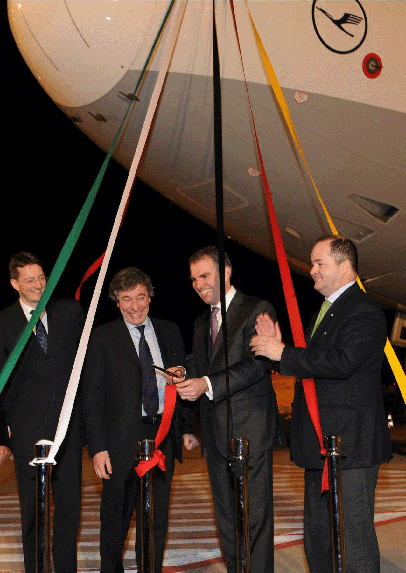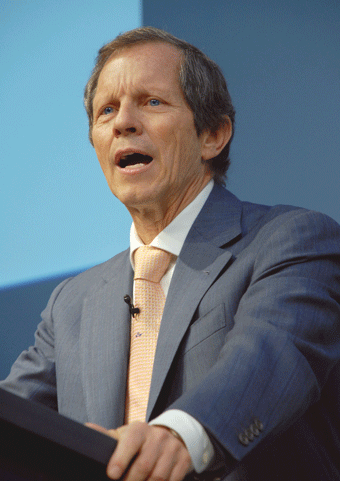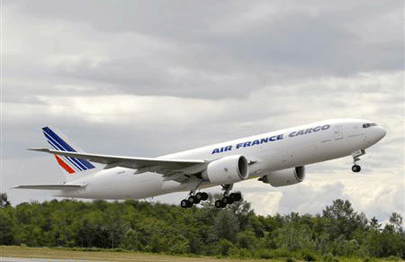Benvenuti Lufthansa Cargo
 Exclusive Malpensa Airport—“Reliability”, “continuity”,
“stability” and “punctuality” those were repeatedly
heard adjectives at Milan’s Malpensa Airport last week on Wednesday
evening.
Exclusive Malpensa Airport—“Reliability”, “continuity”,
“stability” and “punctuality” those were repeatedly
heard adjectives at Milan’s Malpensa Airport last week on Wednesday
evening.
Echoed forwarding agents like Ezio Biffi of
DHL Global Forwarding:
 “These
new flights Lufthansa Cargo offers are nearly perfect for our Italian demand,”
stated the export manager. Words on words topped by Domenico Tafuro (right),
Agility’s Italy CEO, who spoke of a “new era” LH Cargo brings
to the market initiating Italy flights.
“These
new flights Lufthansa Cargo offers are nearly perfect for our Italian demand,”
stated the export manager. Words on words topped by Domenico Tafuro (right),
Agility’s Italy CEO, who spoke of a “new era” LH Cargo brings
to the market initiating Italy flights.
“This forward leading step could only
be taken by an innovative and highly reliable capacity provider such as Lufthansa”,
added Signore Tafuro.
The “step” he spoke of consisted
of basing an MD-11F at Malpensa for offering twice weekly, line-haul flights
to New York (JFK) and Chicago.
The launch flight February 18, departed with
50.7 tons on board.
“This kind of main deck payload to me
doesn’t sound so bad for an inaugural flight,” commented Captain
Armin Klemm who, together with First Officer Torsten Selleny, maneuvered the
craft across the Atlantic.
But first it was ribbon cutting, exercised by
(from left to right) Thilo Schaefer, Country Manager LH Cargo Italy &
Malta, Giuseppe Bonomi, President of Milan’s airport authority SEA S.p.A.
(Malpensa and Linate), Carsten Spohr, CEO LH Cargo and Dario Galli, President
of Varese Province.
In his address to the roughly 200 invited guests
Spohr emphasized the importance of the Italian air freight market “the
second biggest in Europe after Germany,” he said.
When asked by the audience about future plans
of possibly bringing in more aircraft and offering additional frequencies
the manager put the ball right back into the agent’s field by stating
that “the more cargo you hand over to us, the more capacity and freighters
we’ll base here at Milan.”
The heavily industrialized Northern Italian
region is the country’s economic powerhouse.
Main produced and exported commodities are automotive
components, machinery parts, fashion and foodstuff.
“Exactly 48 percent of the entire Italian
air freight is flown in and out Malpensa,” revealed SEA President Giuseppe
Bonomi.
In 2008 this amounted to a total turnover of
404,000 tons at his airport.
Meanwhile with privatized, but still strike-troubled
Alitalia pulling out of Malpensa by relocating most long-haul flights back
to Rome there is a capacity shortage on some routes at Milan.
The continued AZ missteps offer other carriers
like Lufthansa Cargo additional market opportunities.
Said Herr Spohr:
“Lufthansa from the very first days of
existence always sought new business chances.
“So we did now by offering our capacity
at Milan.”
Scheduled road feeder services on behalf of
LH compliment the flights and will secure the flow of shipments to Malpensa,
be it from Rome, Venice or Florence.
“I bet they’ll also conduct reliable
and punctual service with these surface transports,” stated a local
forwarder.
Nice interlude from a world at financial conflict.
Here an almost euphoric expectation after Alitalia’s
Milan retreat.
Air cargo, like love, is where you find it.
Heiner Siegmund

Second In A Series
Here we continue our exclusive wider view of
the world we operate in and what that means to air cargo.
In case you missed the first installment of the series—just
click here.
Gordon Feller, who’s been watching and worrying
about Asian cargo in particular and industry developments in general for more
than 25 years, has created this MegaTrends series exclusively for Air Cargo
News FlyingTypers.
Gordon did his formal academic training at Columbia
University in New York City, where he was a Wallach Fellow and a Lehman Fellow,
and completed graduate work in international affairs.
But as he likes to say—his real-world training
has come from the "school of hard knocks. "
Gordon Feller has written analysis and commentary
for the FT of London, Reuters, Thomson, Informa, Journal of Commerce, McGraw
Hill—and many others.
We welcome your comments and suggestions.
Geoffrey
The global picture of financial power and centricity
has fundamentally changed. Capital markets have become increasingly globalized
and interdependent, with the world’s foreign direct investment (FDI)
flows running at over US$1.8 trillion in 2007 (over three times the level
in 2003) and foreign investors owning over 25% of global equities.
As a result of their spectacular economic growth,
emerging markets are now net providers of capital flows, financing the large
current account deficits of the developed countries, and in particular that
of the US. However, high levels of interdependency bring higher levels of
risk; as the global reach of the U.S. sub-prime crisis demonstrated, challenges
in one market no longer stop at the national boundaries.
As well as being more interconnected, the financial
landscape has been redrawn by the emergence of four new power brokers. Asian
sovereign investors and petro-dollar investors (often using sovereign wealth
funds (SWFs) as investment vehicles) have moved the power base further to
the East, while private equity (PE) and hedge funds have re-defined financing
and leverage. The scale of these power brokers cannot be underestimated; their
combined assets quadrupled between 2000 and 2007 to reach US$11.5 trillion.
They have transformed the financial landscape.
Hedge funds and PE firms will be under pressure
in the short term. While hedge funds have not proven so far to be the systemic
threat that many feared, they have not been able to deliver good returns during
the crisis. Institutional investors, hit by the fall of the equity and credit
markets, are being forced to withdraw their funds from hedge funds in significant
ways to maintain asset allocation ratios; other investors are dissatisfied
with recent weak returns and high fees charged by the funds. They may also
be worried about perceived poor risk controls. Hedge fund industry executives
predict assets under management could fall by 30-40%.
PE firms also face a number of significant challenges:
with credit markets likely to remain tight well into 2009, there will be limited
debt to finance large acquisitions (only 10 PE deals above US$2 billion were
announced between April and October 2008, against 41 deals in the same period
in 2007), forcing PE firms to consider new types of deals (such as minority
equity investments and all-equity investments). The appetite for a short-term
approach to business will continue to be vastly reduced and PE firms will
have to focus more on creating value and risk management in portfolio companies.
Many of the smaller hedge funds and PE firms
will operate with a much lower profile and may disappear (through acquisition
as well as failure) and both industries are likely to be more consolidated,
institutionalized and regulated. In the case of PE, we may see a few very
large, publicly listed, global players with much more diverse offerings (e.g.,
Blackstone); perhaps filling the void being left by investment banks. As regulation
increases around these previously under-regulated areas, we may also see new
types of players emerge — creating niche offerings in the (much smaller)
high-risk, high-reward, low-regulation space.
SWFs have become more yield-seeking, with equity,
PE and hedge fund investments making up a larger proportion of their investment
dollars, and are more actively partnering with corporates. While they may
have been disappointed with loss-making investments done early in the crisis
(e.g., in U.S. banks and PE firms), this is unlikely to put them off for long.
With large reserves (they currently manage funds of US$3 trillion and are
expected to grow to US$10 trillion by 2015), these funds are well positioned
to continue to make some very sizeable and strategic investments, capitalizing
on depressed share prices in the West, and stimulating growth in the East.
The financial crisis may lead some nations to retreat to protectionism, potentially
hampering the growth of these players. However, with liquidity at a premium,
their ready cash is likely to persuade most governments of the benefits of
foreign investment.
As the repercussions against financial innovation
and complex derivatives continue, for the moment the mood in the financial
world is one of simplification and caution. The lines between different types
of financial player were blurring as we headed into the crisis; when we begin
to emerge, the lines should look very different. Traditional investment banks
have suffered heavily. Some household names have collapsed (e.g., Lehman Brothers,
Bear Stearns), and others have changed their capitalization models (linking
up with commercial banks or establishing themselves as bank holding companies)
as their previous business models — and taste for leverage and risk
— failed them. Retail banking has also suffered, with the industry seeing
numerous failures and consolidations; as the worst seems yet to come for the
man on Main Street, this trend is likely to continue.
Governments too are moving back into the spotlight
as financial power moves towards the state; state capitalism is no longer
only found in emerging countries (where around one-fifth of the largest companies
are state-owned), but also in the previously more hands-off West. The
unprecedented step to effectively nationalize banks across Europe and the
U.S. has placed government at the heart of finance, and torn up decades worth
of free-market thinking. Iceland’s pleas for Russian assistance, and
International Monetary Fund (IMF) interventions in Hungary and the Ukraine
have taken this even further. As governments take center stage and nations
take on responsibility for commercial failings, one certainty is that greater
regulation of the financial sector will not be far behind.
Gordon Feller
Next: Overhaul and Globalization of
the Regulatory Environment
IATA Security View Takes Wings
|
|












 Plenty
on the table last week in New York at a meting of The Wings Club as
The International Air Transport Association (IATA) called on the new
USA Administration of President Barack Obama prioritize aviation as
a catalyst to stimulate the U.S. economy.
Plenty
on the table last week in New York at a meting of The Wings Club as
The International Air Transport Association (IATA) called on the new
USA Administration of President Barack Obama prioritize aviation as
a catalyst to stimulate the U.S. economy.

 Contact!
Talk To Geoffrey
Contact!
Talk To Geoffrey